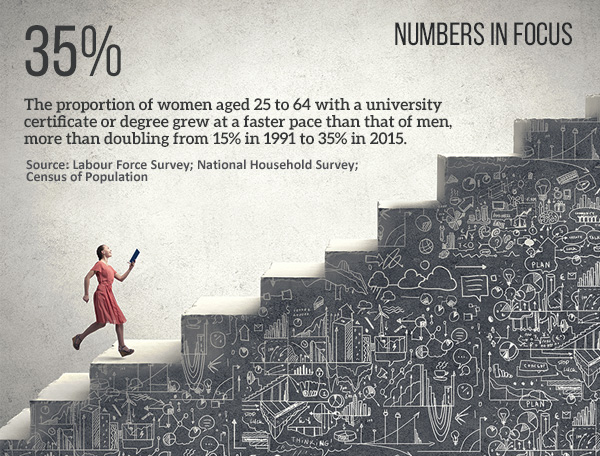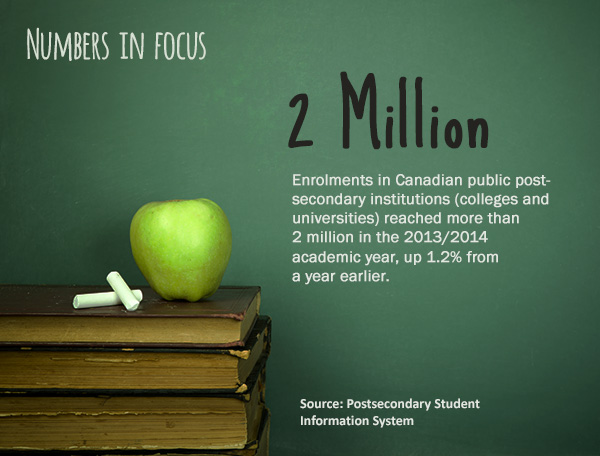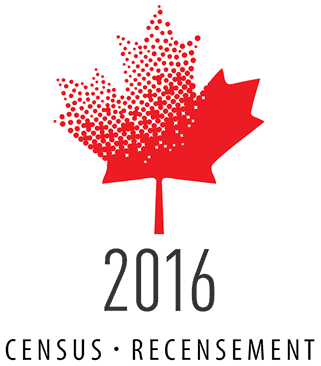The Business & Community Newsletter – September 2016
Archived Content
Information identified as archived is provided for reference, research or recordkeeping purposes. It is not subject to the Government of Canada Web Standards and has not been altered or updated since it was archived. Please "contact us" to request a format other than those available.

It is ‘back to school' season, so in this issue we put the spotlight on education.
Feature articles
Education indicators in Canada: An international perspective, 2015
 This report, Education Indicators in Canada: An International Perspective, is a product of the Pan-Canadian Education Indicators Program (PCEIP). It is intended to facilitate the comparison of educational systems in Canada's provinces and territories with those of countries that belong to the Organization for Economic Co-operation and Development (OECD). The document presents a series of indicators harmonized to the definitions and methodologies used by the OECD in Education at a Glance. The indicators are designed to serve as a basis for decision making and for development of programs in the field of education.
This report, Education Indicators in Canada: An International Perspective, is a product of the Pan-Canadian Education Indicators Program (PCEIP). It is intended to facilitate the comparison of educational systems in Canada's provinces and territories with those of countries that belong to the Organization for Economic Co-operation and Development (OECD). The document presents a series of indicators harmonized to the definitions and methodologies used by the OECD in Education at a Glance. The indicators are designed to serve as a basis for decision making and for development of programs in the field of education.
Study: Do layoffs increase transitions to postsecondary education among adults?, 2001 to 2011
 Every year, thousands of workers lose their job in many industrialized countries. Faced with job loss, displaced workers may choose to return to school to help them reintegrate into the labour force. Job losses in a given local labour market may also induce workers who have not yet been laid off to pre-emptively enroll in postsecondary institutions, as a precautionary measure. Combining microdata and grouped data, this study, Do layoffs increase transitions to postsecondary education among adults?, examines these two dimensions of the relationship between layoffs and postsecondary enrolment over the 2001 to 2011 period.
Every year, thousands of workers lose their job in many industrialized countries. Faced with job loss, displaced workers may choose to return to school to help them reintegrate into the labour force. Job losses in a given local labour market may also induce workers who have not yet been laid off to pre-emptively enroll in postsecondary institutions, as a precautionary measure. Combining microdata and grouped data, this study, Do layoffs increase transitions to postsecondary education among adults?, examines these two dimensions of the relationship between layoffs and postsecondary enrolment over the 2001 to 2011 period.
Women in Canada: Education, qualifications, skills and technology
 Canada's knowledge-based economy – especially the fields of science, technology, engineering and mathematics (STEM) – continues to grow. Related changes in the economy, including shifts to globalized markets and an emphasis on innovation and technology, all mean that education is more and more an integral component of economic and social well-being.
Canada's knowledge-based economy – especially the fields of science, technology, engineering and mathematics (STEM) – continues to grow. Related changes in the economy, including shifts to globalized markets and an emphasis on innovation and technology, all mean that education is more and more an integral component of economic and social well-being.
At the same time, women in Canada have become increasingly well-educated and today represent a larger share of the labour market than they have ever represented previously. However, women continue to have fewer apprenticeship or trades certificates as well as STEM university degrees than their male counterparts. Topics, in Women in Canada: Education, qualifications, skills and technology, include a profile of women's education in Canada, the skills of young girls and women, field-of-study patterns at the postsecondary level, and labour market outcomes, including earnings.
Study: Literacy and numeracy among off-reserve First Nations people and Métis, 2012
 Existing research shows that higher cognitive skills, such as literacy and numeracy, are associated with greater labour force participation and higher earnings, as well as a positive relationship with self-reported health status. However, this research has not focused specifically on the Aboriginal population in Canada.
Existing research shows that higher cognitive skills, such as literacy and numeracy, are associated with greater labour force participation and higher earnings, as well as a positive relationship with self-reported health status. However, this research has not focused specifically on the Aboriginal population in Canada.
The impact that literacy and numeracy have on economic and social outcomes may be especially important for the Aboriginal population as they are typically younger and have a faster rate of population growth than the non-Aboriginal population. In 2011, 46% of Aboriginal people were aged 24 and under, compared with 30% of the non-Aboriginal population. The relatively larger proportion of Aboriginal youth, along with their generally lower levels of education and skills than their non-Aboriginal counterparts, may have important labour market implications for this population. Past research confirms that, in general, the Aboriginal population does not fare as well in the labour market as the non-Aboriginal population, both in terms of employment and earnings. Given the lower educational attainment of the Aboriginal population, it stands to reason that they may be even more vulnerable to downturns in the economy. It is therefore important to understand the factors that may help the Aboriginal population become more fully integrated into the labour market. These are some of the issues examined in the study, Literacy and numeracy among off-reserve First Nations people and Métis.
Study: Diversity of young adults living with their parents, 1981 to 2011
Individuals in their twenties may be engaged in a variety of activities including the pursuit of postsecondary education, finding employment or establishing a career, forming a couple relationship and/or having children. While such a myriad of life changes can provide many opportunities for young adults to grow and develop, there can also be many challenges during these years. Factors such as the high cost of education, economic uncertainty or difficulty finding adequate work, relationship dissolution or conflict, as well as indecision regarding their future all can influence the living arrangements of individuals in their twenties.
One response to their circumstances may be for young adults to live with their parents, either returning after an earlier departure or never leaving. For some young adults—and perhaps their parents as well—co-residence may be seen as a temporary solution until an economic or personal situation improves, while for others it may be a longer-term strategy. While parents and adult children sharing a home is generally perceived to be more beneficial for the younger generation, exchanges of support—financial, emotional or otherwise—could occur in both directions.
In the decades since 1981, there has been an overall upward trend in the proportion of young adults aged 20 to 29 living in the same home as their parents. At the same time, there has been an increase in the ethnocultural diversity of the overall population, which, in turn, can influence living-arrangement patterns. This study, Diversity of young adults living with their parents, examines the extent to which parental co-residence is associated with the particular ethnocultural, socioeconomic and geographic characteristics of young adults.
Did you know that?
 The number of students enrolled in French immersion programs in 2013/2014 was 392,430, up 5.5% from the previous academic year.
The number of students enrolled in French immersion programs in 2013/2014 was 392,430, up 5.5% from the previous academic year.
The average amount paid in tuition fees by Canadian full-time undergraduate students in the 2015/2016 academic year was $6,191, compared with $5,998 the previous year.
The proportion of women among all elementary school and kindergarten teachers in Canada in 2011 was 84%.
For more on the subject, have a look at Back to school... by the numbers, 2016.
Numbers in focus
Every month we put a couple of interesting numbers in the spotlight!

Numbers in Focus - 35%
The proportion of women aged 25 to 64 with a university certificate or degree grew at a faster pace than that of men, more than doubling from 15% in 1991 to 35% in 2015.
Source: Labour Force Survey; National Household Survey; Census of Population

Numbers in Focus - 2 Million
Enrolments in Canadian public postsecondary institutions (colleges and universities) reached more than 2 million in the 2013/2014 academic year, up 1.2% from a year earlier.
Source: Postsecondary Student Information System
What's new?
Webinars
 Register for free online learning sessions on FINDING EDUCATION DATA, in English & French!
Register for free online learning sessions on FINDING EDUCATION DATA, in English & French!
Learn useful tips on how to access education data on Statistics Canada's website.
Please click on link below to register:
Topic: Finding Education Data (in English)
Date: Wednesday, October 19, 2016
Time: 1:00 pm, Eastern Daylight Time (Toronto, GMT-04:00)
Topic: Comment trouver des données sur l'éducation (in French)
Date: Thursday, October 20, 2016
Time: 1:00 pm, Eastern Daylight Time (Toronto, GMT-04:00)
Limited spaces available so please register early.
Also worth reading
Canadians' overwhelming response enables 'best ever' Census in 2016
 The willing participation of Canadians has enabled Statistics Canada to achieve the 'best Census ever,' the agency announced on August 29.
The willing participation of Canadians has enabled Statistics Canada to achieve the 'best Census ever,' the agency announced on August 29.
The overall collection response rate of 98.4 per cent for the 2016 Census of Population is higher than for both the 2011 and 2006 Census programs.
In 2016, the collection response rate for the long form was 97.8 per cent, the best ever recorded. This response rate will enable the provision of high-quality information for virtually all communities.
The 2016 Census also stood out in two other regards: self-response and Internet response. Almost 9 in 10 Canadian households completed their long or short form questionnaire without any assistance from Statistics Canada staff. The rate of 88.8 per cent makes this the most efficient among traditional censuses conducted in the world.
For the Internet response, Canadians delivered a gold medal performance with an Internet response rate of 68.3 per cent, surpassing the ambitious initial objective of 65 per cent and setting yet again another world record.
Statistics Canada will now turn its focus to providing high quality Census information. An accelerated release schedule is planned to provide Canadians with results in a more timely fashion than for any previous census. First results from the 2016 Census will be published on February 8, 2017, with the release of data on population and dwelling counts.
As well, Statistics Canada continues to plan for future censuses. Consultations on census content for 2021 will take place in 2017. The agency will seek to further refine collection processes, with a view to ensuring the 2021 Census continues to improve inclusiveness, data quality and efficiency.
For more information on the census, please visit Statistics Canada's website.
Study: New facts about financial literacy in Canada, 2014
 There is a gap in financial knowledge between men and women, especially among older and more educated Canadians.
There is a gap in financial knowledge between men and women, especially among older and more educated Canadians.
Also, a higher level of financial knowledge is more often associated with a higher degree of retirement preparation among labour market participants.
These findings are included in two studies, which are based on data from the Canadian Financial Capability Survey. In the survey, a 14-question quiz was administered to respondents to assess their financial literacy.
The first article, "Gender differences in the financial knowledge of Canadians," and the second article, "Financial literacy and retirement planning," are now available in Insights on Canadian Society.
- Date modified:
